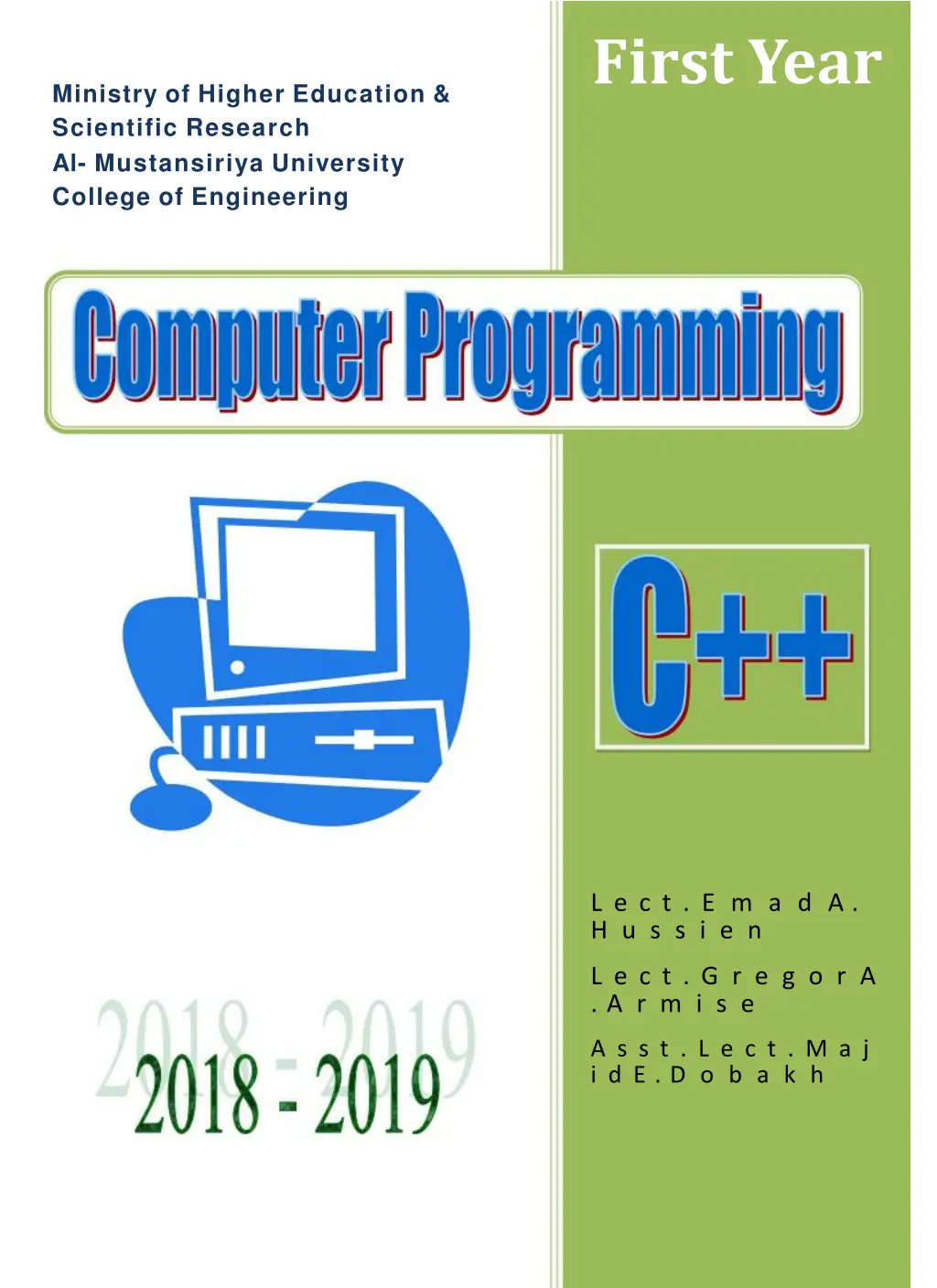
Algorithm Examples & Flowcharts for Programming Beginners
Explore algorithm examples and flowcharts for beginners in programming. Learn how to check for prime numbers, calculate sums, work with loops, and more with detailed explanations and visual aids. Start your programming journey with these step-by-step guides!
Download Presentation

Please find below an Image/Link to download the presentation.
The content on the website is provided AS IS for your information and personal use only. It may not be sold, licensed, or shared on other websites without obtaining consent from the author. If you encounter any issues during the download, it is possible that the publisher has removed the file from their server.
You are allowed to download the files provided on this website for personal or commercial use, subject to the condition that they are used lawfully. All files are the property of their respective owners.
The content on the website is provided AS IS for your information and personal use only. It may not be sold, licensed, or shared on other websites without obtaining consent from the author.
E N D
Presentation Transcript
First Year Ministry of Higher Education & Scientific Research Al- Mustansiriya University College of Engineering L e c t . E m a d A . H u s s i e n L e c t . G r e g o r A . A r m i s e A s s t . L e c t . M a j i d E . D o b a k h
1- General form This type of counters can be represented according to the following form: Where: I=S I : Counter name (may take any symbol) S: Initial (Starting) value I=I+ Repeated operation E: End (Final) value Yes : Step size (if not indicated, its value will be 1) I E No 2. Conventional form. The form of this type of counters will be as shown: Starting the counter I = S , E , Repeated operation 1 E x a m p l e - 6 : Write an algorithm and draw a flow chart to enter any number and check it whether its primary number or not. Use the conventional form.
Start S o l u t i o n : 1. Start 2. Input x 3. For I=2 To x-1 step 1 4. If Reminder ((x / I) = 0); goto-7 Else; continue 5. Next I 6. Print Primary number ;goto-8 7.Print Not a primary number 8. End Input x For I=2 to x-1 step 1 Yes Is Rem (x/I=0)? Print Not Primary No 1 Pint Primary End E x a m p l e - 7 : Write an algorithm Start and draw a flow chart to print the odd S=0 , N=0 numbers from 1 to 90 then find and print its number and sum. Use the conventional form. K = 1, 90 S o l u t i o n : 1. Start 2. Put S = 0 , N = 0 3. For K=1 To 90 step 1 4. Find sum of odds, S=S+K 6. Find number of odds, N=N+1 7. Print K 8. Next I 9. Print S , N 10. End S=S+K , N=N+1 Print K 1 Print S , N End
E x a m p l e - 8 : Writean algorithm and draw a flow chart find the sum and number of positive numbers among 50 numbers entered by user. Use the general form. S o l u t i o n : Start 1. Start 2. Put I = 1, S=0, N=0 I=1 , S=0 , N=0 3. Input x Input X 4. If (x>=0) ; continue Else ; goto-7 No X>0 5. Find Sum (S), S=S+x Yes I=I+1 S=S+X , N=N+1 6. Find Number (N), N=N+1 7. If (I 50) ; I=I+1; goto-3 Else ; continue Yes I 50 No 8. Print S , N Print S,N 9.End End 2-2-4: Multi-loops charts. Its so called because it contains many loops. These loops are nested together without any intersection. Loop no.1 (shown in figure beside) is called "inner loop" and loop no.2 is the outer loop. 2 1 The priority of execution will be to the inner loops then sequentialy to the outer loops. Program execution direction
E x a m p l e - 8 : Write an algorithm and draw a flowchart that shows how did the digital clock worked. Start For H= 0 to 24 S o l u t i o n : For M = 0 to 60 1. Start 2. For H(Hours) = 0 to 24 For S = 0 to 60 3. For M(Minutes) = 0 to 60 Print H , M , S 4. For S(Seconds) = 0 to 60 5. Print H, M, S 3 6. Next S 2 7. Next M 8. Next H 1 9. End End E x a m p l e - 9 Write an algorithm and draw a flowchart to print the Start multiplication table from 1 to 10. For I= 1 to 10 For J = 1 to 10 S o l u t i o n : 1. Start M = I * J 2. For I = 1 to 10 Print M 3. For J =1 to 10 4. M = I * J 2 5. Print M Print 6. Next J 7. Print 1 8. Next I End 9. End
WORK SHEET (1) Q 1 : Write an algorithm and draw a flowchart to calculate A1, A2, A3 from the following equation: A1 = X2+Y2 , A2 =A1-3XY , A3 = |A1||A2| Where X and Y are evaluated from the equations: 3 X ,Y = z 4 z PrintA1,A2,A3 for each input value of z. Q 2 :Write an algorithm and draw a flowchart to calculate W from the following equations: X X Y 2X 3Y : X 0 , Y 0 , Y 0 0 Y W 2 3 5 X : X 4X :X 0,Y 0 Print W for each input value of X and Y. Q 3 :Draw a flowchart to enter a number represents a Celsius degree (C) then convert it to Fahrenheit degree (F) then print the grade of this degree using the following relations: Cold when F 41. Nice when 41< F 77. when F >77. Hot Hint: F = (9C / 5) + 32 Q 4 :Write an algorithm and draw a flowchart to find Y from the bellow equations for seven entering values of X. If you know that a=-8, print the value of Y for each value of X. Use the conventional form. 3X X :X 0 2 Y X a :X 0
Q 5 : A list contains N-degrees in computer course, draw a flowchart to calculate the percentage rate for the degrees limited between 60% and 70%. Use the conventional form. Q 6 :Write an algorithm and draw a flowchart to enter a 40 numbers then find and print number and sum for the numbers greater than 0 and less than 25. Use the general form. Q 7 : Write an algorithm and draw a flowchart to enter a 50 numbers then find and print number and sum for the positive and negative numbers. Use the conventional form. Q 8 : Write an algorithm and draw a flowchart to find and print number and sum for the even and odd numbers for M-entered numbers. Use the conventional form. Q 9 : Byusing the conventional form, draw a flowchart to find and print the power on the resistor R4. 250 500 20V 300 R 4 (100 2000 ) step100 Enter two numbers represents two readings for an Q 1 0 : Consumption unit Cost (in Dinar) electrical power 8 1 300 10 consumption in the first and end of a 301 360 20 361 000 specific evaluate the consumption wage for 50 month. Draw a flowchart to 901 30 consumers according to the following table: Hint: W = (R2 R1) Cost per unit Average Grade Q 1 1 : A list contains six degrees for 100 students, draw a Fail 0 - 49 Accept Fluent Good Very Good Excellent 50 - 59 flowchart to enter these degrees and find the average then 60 - 69 70 - 79 print the grade of this average according to table below. Use the conventional form. 80 - 89 90 - 100






















